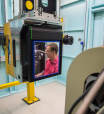Australian Synchrotron to join consortium mapping the human brain
Consortium will map the 86 billion nerve cells, 100 trillion connections and neurotransmitters in the human brain.

Showing 61 - 80 of 224 results
Consortium will map the 86 billion nerve cells, 100 trillion connections and neurotransmitters in the human brain.
ANSTO researchers contribute to study which finds evidence of Aboriginal occupation 65,000 years ago in Northern Australia.
The Australian Academy of Technology and Engineering (ATSE) has elected Professor Andrew Peele, Director of ANSTO’s Australian Synchrotron, to become a Fellow of the prestigious organisation.

This program explores the mechanism and outcome of the interaction of radiation on biological systems in order to improve our understanding of the impact of radiation on the brain, optimise radiotherapy and develop mitigation strategies for space travellers.

Designed to address the new 2026 NSW Science Stage 4 (Year 7-8) syllabus, this tour is a hands-on introduction to atomic structure, the properties and classification of some elements, and the structure of the periodic table. Students will do a series of hands-on activities using the workbook below.
All tours are available Monday to Friday for Years 7 to 12 classes.
The cost per student is $12.50 and teachers are free.
Teachers are requested to print enough copies of the relevant workbook for their class before their visit to ANSTO, as students will not be permitted to bring digital devices on-site.
An international collaboration led by The University of Sydney and supported by ANSTO has developed an advanced, innovative artificial intelligence application that could be used to help examine tissue samples and identify signs of disease/

The Medium Energy- X-ray Absorption Spectroscopy beamlines will provide access to XANES and EXAFS data from a bending magnet source, optimised for cutting-edge applications in biological, agricultural and environmental science in an energy range that is not currently available at the Australia Synchrotron.

The High Performance Macromolecular Crystallography beamline will enable the study of very small (sub-5 micrometre) or weakly diffracting crystals, providing a state-of-the-art high-throughput facility for researchers. MX3 will be able to study the structures of large proteins and protein complexes for virology, drug design and industrial applications via goniometer mounted crystals, in-tray screening, or via serial crystallography methods.

Health researchers at ANSTO use world-class nuclear and isotopic techniques to undertake research and development activities to address some of the most challenging health problems.
The mechanical, electrical, chemical, optical and thermal properties of glass, as determined by its chemical composition and atomic structure, make it a highly useful material with a myriad of applications.

ANSTO part of consortium funded by Federal Government to develop new radioimmunological drugs.